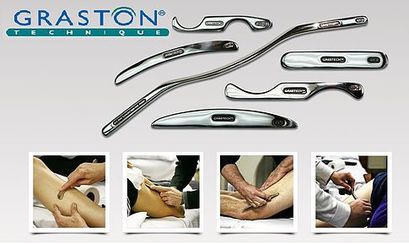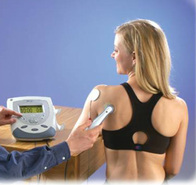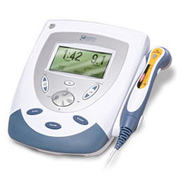Graston Technique

The Graston Technique is a form of manual therapy known as soft-tissue instrument-assisted mobilization. It is one of a number of manual therapy approaches that uses instruments with a specialized form of massage/scraping the skin gently. The therapy is designed to help the practitioner identify areas of restriction and attempt to break up scar tissue.The general goals of the therapy are to reduce the patient's pain and increase function through a combination of:
The Graston Technique offers several potential advantages to the patient with such an injury:
- Breaking down the scar tissue and fascia restrictions that are usually associated with some form of trauma to the soft tissue.
- Reducing restrictions by stretching connective tissue in an attempt to rearrange the structure of the soft tissue being treated. Promoting a better healing environment for the injured soft tissue.
The Graston Technique offers several potential advantages to the patient with such an injury:
- Decreasing overall treatment time
- Fostering faster rehabilitation/recovery
- Reducing the need for anti-inflammatory medications
- Resolving chronic conditions thought to be permanent
Electrical Muscle Stimulation

Electrical Muscle Stimulation is an exceptional way to help the body in the healing process. This is accomplished by sending a very small electrical current into the affected soft tissue injury or muscle spasm. The therapy utilizes this current in an effort to help reduce swelling and release trigger points that may have the muscle locked up. It does this by helping the body to release natural relievers of pain often referred to as endorphins.
This is a great therapy if there is a spasm in a back or neck muscle. It works well in relaxing the muscle and allowing it to return to its normal state rather quickly. Short therapy sessions are excellent at facilitating healing from acute and chronic pain.
This is a great therapy if there is a spasm in a back or neck muscle. It works well in relaxing the muscle and allowing it to return to its normal state rather quickly. Short therapy sessions are excellent at facilitating healing from acute and chronic pain.
Ultrasound

Ultrasound is a therapy that is utilized in the office to handle injuries related to joints, muscle spasms, as well as most soft tissues. While it shares the same name, this ultrasound is not the same as the type of ultrasound utilized diagnostically to screen internally in the body. This ultrasound creates small sound waves that in effect vibrate and massage soft tissues and muscle. These sound waves do an excellent job in facilitating the body's healing process in addition to decreasing scar tissue formation.
Certain ultrasounds also create a heating effect to help relax the muscles or tightness in the body. This heat combined with the overall features of the ultrasound help to start the healing process at the most basic cellular level speeding up your road to recovery.
Certain ultrasounds also create a heating effect to help relax the muscles or tightness in the body. This heat combined with the overall features of the ultrasound help to start the healing process at the most basic cellular level speeding up your road to recovery.
Cold Laser

Cold Laser Therapy is an excellent treatment that is often utilized to treat a wide array of conditions and pain. This therapy allows the body to naturally heal itself by utilizing a combination of electric stimulation and cold laser technology. This low level laser therapy consists of a light-emitting device that can be utilized on many different parts of the body.
In addition to simple back and neck pain, cold laser therapy has been utilized for a number of inflammatory conditions such as arthritis, tendonitis and sprains. The number of conditions that have been notably increased in the usage of this therapy include carpal tunnel syndrome, wound management, shoulder and neck injuries, muscle and joint pain, as well as a long list of others.
In addition to simple back and neck pain, cold laser therapy has been utilized for a number of inflammatory conditions such as arthritis, tendonitis and sprains. The number of conditions that have been notably increased in the usage of this therapy include carpal tunnel syndrome, wound management, shoulder and neck injuries, muscle and joint pain, as well as a long list of others.
